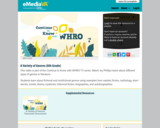
Each student writes a one paragraph summary of a chapter of a book and then illustrates their chapter. It can be used for a book the whole class is reading so then all of the summaries are collected and bound together to create a “summary book” of the book read. This activity can be used for both fiction and non-fiction books in any subject and any grade, although this activity is linked to upper primary SOLs. This activity assesses reading comprehension and practices all writing skills. It also includes Art SOLs, and if you have students create their final products on the computer, then you would be incorporating the Computer Technology SOLs as well. If it is used for a non-fiction text in a different content class, then the activity would also cover those SOLs. It can be used for EL classes in middle school also.
- Subject:
- Cross-Curricular
- ESL
- English
- English Language Development (ELD)
- Reading
- Visual Art
- Writing
- Material Type:
- Activity/Lab
- Assessment
- Homework/Assignment
- Lesson Plan
- Author:
- Laura Brown
- Date Added:
- 07/30/2020
